Nanosensors — Limitless Possibilities
An introduction to nanotechnology:
Nanobots, nanotech, nanosensors — if these words ring a bell, it’s probably because you’ve heard these popular buzzwords thrown around in sci-fi movies, referring to some kind of minuscule technology. But the prefix “nano” is so much more than just a popular sci-fi cliché. In this article, I’ll be going into depth about today’s nanotechnology revolution and more specifically, the importance of and issues with nanosensors.
The NNI:
NNI- the National Nanotechnology Initiative is a $422 million initiative approved by the US government in 2001. This initiative was meant to show to the US population that nanotechnology was more than just something out of a Sci-Fi movie and could become a valuable asset to the growing US economy. Today, a relatively large $1.4 billion chunk of the US annual budget goes to the NNI. For perspective, the TSA receives roughly $7.7 billion a year in funding. With all this funding, the industry got a huge kickstart and began to produce some promising results, including nanosensors.
What exactly are nanosensors?
Nanosensors by definition are sensors that fall into one of two categories: they’re either in the nanoscale themselves, or they measure factors in the nanoscale but aren’t necessarily in the nanoscale. The nanoscale usually refers to structures between 1–100 nanometers in size. For perspective, the average 0.1mm thick piece of paper is actually 100,000 nanometers wide! The extremely small scale of these sensors allows for many significant advantages over traditional sensors, including:
- Much more accurate results
- Much faster speeds allowing for real-time data collection/transfer
- The advantage of greatly reduced or often non-existent power consumption
- Their minuscule scale allows for non-intrusive or discreet measurement
But why should I care?
Nanosensors and nanotechnology have potential in almost every industrial or medical application. The different types can detect physical, chemical, or biological changes at a scale never seen before. Nanosensors have many extremely useful and potentially life-saving applications — more on that later. There are various categories of nanosensors such as optical nanosensors, electrochemical nanosensors, chemical nanosensors, and others, that can all be used effectively. Some of the more prominent use cases include:
- Monitoring air and water quality
- Monitoring cellular health during cancer treatments
- Searching for early stages of cancer in a non-invasive manner
- Monitoring organ health
- Forensics
- Virus detection.
While the development of nanosensors for these applications is still expensive, there have been some very promising results in testing, making further research and development worthwhile.
How do they work?
Nanosensors work by detecting a change in their surroundings and converting it into a readable signal. Most nanosensors function by detecting an electrical change in the sensor material, and converting the data into a signal that can be analyzed by a computer or a human. For instance, when a carbon-nanotube sensor is exposed to ammonia, it receives an electron, which is then detected and converted into a signal which can then be interpreted by a human, computer, or other components of a machine.
How they’re made (Nanofabrication)
Nanofabrication is a complex and daunting process. There are two main approaches to creating nanosensors and other nanotechnology. The first approach (the more conventional manner), called top-down nanofabrication can be looked at as sculpting a pre-existing material down to the desired form for the nanosensor or other device to work appropriately. Nanolithography is by far the most common form of top-down nanofabrication, and while there are various different methods (optical, electron-beam, etc.), they all fundamentally work the same way; by starting off with a material and sculpting it to the shape needed for proper function. The other approach (the unconventional method), bottom-up nanofabrication can be looked at as building a house, brick by brick. In this approach, the individual molecules or atoms are placed one by one until the desired shape is created. In some cases, special chemical reactions can be used to cause the molecules to assemble themselves into the appropriate shape. There are many different methods for bottom-up nanofabrication, such as vacuum arc deposition, atomic layer deposition, metal-organic chemical vapour deposition, electric arc deposition, sputter deposition, and others.
Some of the outstanding issues with nanofabrication:
Both methods of nanofabrication present their own issues. Top-down is much quicker and more efficient but the machinery required for this process is much more expensive than the alternative, meaning higher capital cost. The opposite is the case with the bottom-up nanofabrication approach. It takes a lot longer but the initial cost is significantly cheaper than top-down. So how can we fix these problems?
Improving nanofabrication:
While I was only introduced to nanotechnology a mere 4 days ago, from my limited knowledge, it seems to me that the method of improving nanofabrication that shows the most promise is to continue building on the bottom-up approach, to make it faster, cheaper, and more efficient than what it currently is. I believe that continuing to develop and improve on the bottom-up method by doing things such as utilizing new materials and implementing some of the positives of top-down is the best way to move towards a future where nanotechnology can be used to its full potential.
